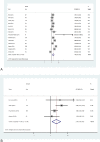Do digital innovations for HIV and sexually transmitted infections work? Results from a systematic review (1996-2017)
- PMID: 29101138
- PMCID: PMC5695353
- DOI: 10.1136/bmjopen-2017-017604
Do digital innovations for HIV and sexually transmitted infections work? Results from a systematic review (1996-2017)
Abstract
Objective: Digital innovations with internet/mobile phones offer a potential cost-saving solution for overburdened health systems with high service delivery costs to improve efficiency of HIV/STI (sexually transmitted infections) control initiatives. However, their overall evidence has not yet been appraised. We evaluated the feasibility and impact of all digital innovations for all HIV/STIs.
Design: Systematic review.
Setting/participants: All settings/all participants.
Intervention: We classified digital innovations into (1) mobile health-based (mHealth: SMS (short message service)/phone calls), (2) internet-based mobile and/or electronic health (mHealth/eHealth: social media, avatar-guided computer programs, websites, mobile applications, streamed soap opera videos) and (3) combined innovations (included both SMS/phone calls and internet-based mHealth/eHealth).
Primary and secondary outcome measures: Feasibility, acceptability, impact.
Methods: We searched databases MEDLINE via PubMed, Embase, Cochrane CENTRAL and Web of Science, abstracted data, explored heterogeneity, performed a random effects subgroup analysis.
Results: We reviewed 99 studies, 63 (64%) were from America/Europe, 36 (36%) from Africa/Asia; 79% (79/99) were clinical trials; 84% (83/99) evaluated impact. Of innovations, mHealth based: 70% (69/99); internet based: 21% (21/99); combined: 9% (9/99).All digital innovations were highly accepted (26/31; 84%), and feasible (20/31; 65%). Regarding impacted measures, mHealth-based innovations (SMS) significantly improved antiretroviral therapy (ART) adherence (pooled OR=2.15(95%CI: 1.18 to 3.91)) and clinic attendance rates (pooled OR=1.76(95%CI: 1.28, 2.42)); internet-based innovations improved clinic attendance (6/6), ART adherence (4/4), self-care (1/1), while reducing risk (5/5); combined innovations increased clinic attendance, ART adherence, partner notifications and self-care. Confounding (68%) and selection bias (66%) were observed in observational studies and attrition bias in 31% of clinical trials.
Conclusion: Digital innovations were acceptable, feasible and generated impact. A trend towards the use of internet-based and combined (internet and mobile) innovations was noted. Large scale-up studies of high quality, with new integrated impact metrics, and cost-effectiveness are needed. Findings will appeal to all stakeholders in the HIV/STI global initiatives space.
Keywords: hiv; innovations; mhealth/ehealth; sexually transmitted infections; systematic reviews.
© Article author(s) (or their employer(s) unless otherwise stated in the text of the article) 2017. All rights reserved. No commercial use is permitted unless otherwise expressly granted.
Conflict of interest statement
Competing interests: None declared.
Figures
References
-
- The World Health Organization. Sexually transmitted infections (STIs): fact sheet N°110: WHO media centre, 2015. Updated Dec 2015 http://www.who.int/mediacentre/factsheets/fs110/en/ (accessed 27 Jan 2016).
-
- The World Health Organization. Hepatitis B: fact sheet N°204: WHO media centre. 2015. http://www.who.int/mediacentre/factsheets/fs204/en/ (accessed 27 Jan 2016).
-
- The World health Organization. Hepatitis C: fact sheet N°164, 2015. http://www.who.int/mediacentre/factsheets/fs164/en/ (accessed 27 Jan 2016).
-
- The Joint United Nations Programme on HIV/AIDS. Fact Sheet 2015, 2015. http://www.unaids.org/en/resources/campaigns/HowAIDSchangedeverything/fa... (accessed 17 Dec 2016).
Publication types
MeSH terms
LinkOut - more resources
Full Text Sources
Other Literature Sources
Medical



